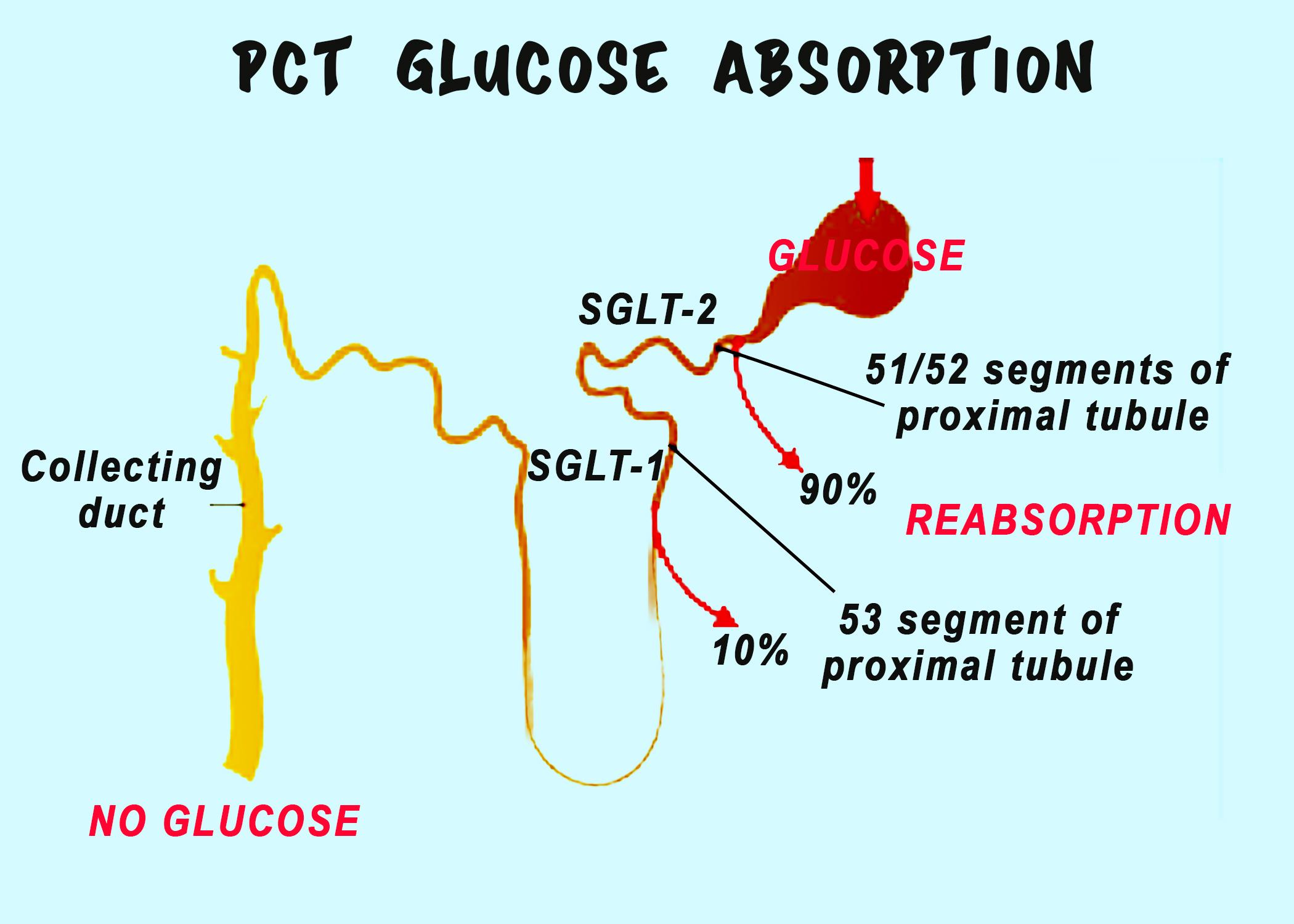
Answer
444.9k+ views
Hint Glucose is a monosaccharide which is a category of carbohydrate and is made by plants and algae during the process of photosynthesis from water and carbon dioxide by using energy from sunlight.
Complete answer:
In the kidney, glucose is mainly absorbed in the proximal convoluted tubules which is the segment of nephron present in the kidney. It consists of a luminal brush border which is present on the luminal surface of the epithelial cells of the nephron and is covered with densely packed microvilli that form a border that is visible under the light microscope and gives the brush border cell its name. The cytoplasm within the cell is densely packed and is largely found in the basal region with the high quantity of mitochondria that gives the cell an acidophilic appearance. The proximal tubule is divided into two sections which are the pars convoluted and the pars recta. The pars convoluta is the initial convoluted portion and the pars recta are the straight descending portion. The tubule helps with the regulation of pH of the filtrate by exchanging hydrogen ions and is responsible for the secretion of organic acids such as creatinine and others.
Additional information:
The kidney is not a major organ of the lymphatic system. The lymphatic system is not a closed system and helps in the functioning of immune defence. The kidney is an organ that is bean-shaped and constitutes the renal system. It helps in passing the urine waste from the body and in the filtering of the blood before sending it back to the heart. It maintains the overall fluid balance and regulates the minerals from the blood. The waste materials from food, medications, and toxic substances get filtered by the kidney. It helps in creating hormones that produce red blood cells and regulate blood pressure and promotes bone health. It is about 12 cm in length in adult humans and receives blood from the paired renal arteries. The nephron is the structural and functional unit of the kidney which is produced around 1 million in an adult human.

So, the correct answer is 'Proximal convoluted tubules'.
Note: An average kidney weighs up to 4 to 6 ounces and is big as a cellphone. It is estimated that people can live without Kidneys but require dialysis and the spleen can be removed if it’s damaged and people without a spleen are more prone to infections.
Complete answer:
In the kidney, glucose is mainly absorbed in the proximal convoluted tubules which is the segment of nephron present in the kidney. It consists of a luminal brush border which is present on the luminal surface of the epithelial cells of the nephron and is covered with densely packed microvilli that form a border that is visible under the light microscope and gives the brush border cell its name. The cytoplasm within the cell is densely packed and is largely found in the basal region with the high quantity of mitochondria that gives the cell an acidophilic appearance. The proximal tubule is divided into two sections which are the pars convoluted and the pars recta. The pars convoluta is the initial convoluted portion and the pars recta are the straight descending portion. The tubule helps with the regulation of pH of the filtrate by exchanging hydrogen ions and is responsible for the secretion of organic acids such as creatinine and others.
Additional information:
The kidney is not a major organ of the lymphatic system. The lymphatic system is not a closed system and helps in the functioning of immune defence. The kidney is an organ that is bean-shaped and constitutes the renal system. It helps in passing the urine waste from the body and in the filtering of the blood before sending it back to the heart. It maintains the overall fluid balance and regulates the minerals from the blood. The waste materials from food, medications, and toxic substances get filtered by the kidney. It helps in creating hormones that produce red blood cells and regulate blood pressure and promotes bone health. It is about 12 cm in length in adult humans and receives blood from the paired renal arteries. The nephron is the structural and functional unit of the kidney which is produced around 1 million in an adult human.

So, the correct answer is 'Proximal convoluted tubules'.
Note: An average kidney weighs up to 4 to 6 ounces and is big as a cellphone. It is estimated that people can live without Kidneys but require dialysis and the spleen can be removed if it’s damaged and people without a spleen are more prone to infections.
Recently Updated Pages
A wire of length L and radius r is clamped rigidly class 11 physics JEE_Main

For which of the following reactions H is equal to class 11 chemistry JEE_Main

For the redox reaction MnO4 + C2O42 + H + to Mn2 + class 11 chemistry JEE_Main

In the reaction 2FeCl3 + H2S to 2FeCl2 + 2HCl + S class 11 chemistry JEE_Main

One mole of a nonideal gas undergoes a change of state class 11 chemistry JEE_Main

A stone is projected with speed 20 ms at angle 37circ class 11 physics JEE_Main

Trending doubts
Which is the longest day and shortest night in the class 11 sst CBSE

Who was the Governor general of India at the time of class 11 social science CBSE

Why is steel more elastic than rubber class 11 physics CBSE

Difference between Prokaryotic cell and Eukaryotic class 11 biology CBSE

Define the term system surroundings open system closed class 11 chemistry CBSE

State and prove Bernoullis theorem class 11 physics CBSE




